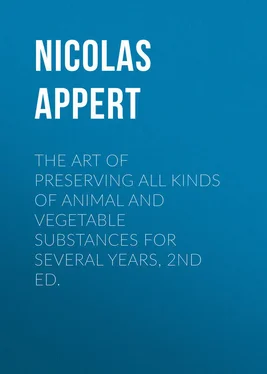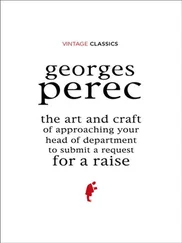Nicolas Appert - The Art of Preserving All Kinds of Animal and Vegetable Substances for Several Years, 2nd ed.
Здесь есть возможность читать онлайн «Nicolas Appert - The Art of Preserving All Kinds of Animal and Vegetable Substances for Several Years, 2nd ed.» — ознакомительный отрывок электронной книги совершенно бесплатно, а после прочтения отрывка купить полную версию. В некоторых случаях можно слушать аудио, скачать через торрент в формате fb2 и присутствует краткое содержание. Жанр: foreign_antique, foreign_prose, на английском языке. Описание произведения, (предисловие) а так же отзывы посетителей доступны на портале библиотеки ЛибКат.
- Название:The Art of Preserving All Kinds of Animal and Vegetable Substances for Several Years, 2nd ed.
- Автор:
- Жанр:
- Год:неизвестен
- ISBN:нет данных
- Рейтинг книги:5 / 5. Голосов: 1
-
Избранное:Добавить в избранное
- Отзывы:
-
Ваша оценка:
- 100
- 1
- 2
- 3
- 4
- 5
The Art of Preserving All Kinds of Animal and Vegetable Substances for Several Years, 2nd ed.: краткое содержание, описание и аннотация
Предлагаем к чтению аннотацию, описание, краткое содержание или предисловие (зависит от того, что написал сам автор книги «The Art of Preserving All Kinds of Animal and Vegetable Substances for Several Years, 2nd ed.»). Если вы не нашли необходимую информацию о книге — напишите в комментариях, мы постараемся отыскать её.
The Art of Preserving All Kinds of Animal and Vegetable Substances for Several Years, 2nd ed. — читать онлайн ознакомительный отрывок
Ниже представлен текст книги, разбитый по страницам. Система сохранения места последней прочитанной страницы, позволяет с удобством читать онлайн бесплатно книгу «The Art of Preserving All Kinds of Animal and Vegetable Substances for Several Years, 2nd ed.», без необходимости каждый раз заново искать на чём Вы остановились. Поставьте закладку, и сможете в любой момент перейти на страницу, на которой закончили чтение.
Интервал:
Закладка:
6. A bottle-boot or block, standing on three legs, and provided with a strong bat for corking. ( Fig. 5. EXPLANATION OF THE PLATE • Fig. 1. A reel with two iron bars, made use of to double the wire, and cut the doubled wire twice the length required for fixing the corks in the bottles. • Fig. 2. A small machine for twisting the wire one-third of its length after having been doubled by fig. 1. • Fig. 3. An instrument for compressing (and, as it were, biting) the corks three quarters of their length, beginning at the smallest end. • Fig. 4. A stool stuffed with straw, furnished with a wooden stand on which the bottles may be placed to be tied. The same stool will serve to sit on during the corking. • Fig. 5. A hollow block of wood, called a bottle-boot (Casse-Bouteille), within which the bottle is set when it is to be corked. This bottle-boot is furnished with a strong bat for beating in the corks. • Fig. 6. A front and side view of pointed pincers, used for twisting the wire employed to keep on the corks, and for cutting off the superfluous ends of the wire. I make use of flat pincers and scissars for this operation. Neele sc. Strand London Published 25 th . Feb y . 1811 by Black & C o . Leadenhall Str.
)
7. A stool standing on five legs, for tying on the corks. ( Fig. 4. EXPLANATION OF THE PLATE • Fig. 1. A reel with two iron bars, made use of to double the wire, and cut the doubled wire twice the length required for fixing the corks in the bottles. • Fig. 2. A small machine for twisting the wire one-third of its length after having been doubled by fig. 1. • Fig. 3. An instrument for compressing (and, as it were, biting) the corks three quarters of their length, beginning at the smallest end. • Fig. 4. A stool stuffed with straw, furnished with a wooden stand on which the bottles may be placed to be tied. The same stool will serve to sit on during the corking. • Fig. 5. A hollow block of wood, called a bottle-boot (Casse-Bouteille), within which the bottle is set when it is to be corked. This bottle-boot is furnished with a strong bat for beating in the corks. • Fig. 6. A front and side view of pointed pincers, used for twisting the wire employed to keep on the corks, and for cutting off the superfluous ends of the wire. I make use of flat pincers and scissars for this operation. Neele sc. Strand London Published 25 th . Feb y . 1811 by Black & C o . Leadenhall Str.
)
8. A sufficient quantity of linen bags, for covering the bottles and other vessels.
9. Two stools covered with leather and stuffed with hay, in order to shake the bottles upon them, and in that way force a greater number of peas and other small substances into the bottles.
10. A press for the juice of plants, fruits, and herbs; with pans, vessels, sieves, and every thing else that belongs to it.
Besides my laboratory, consisting of these articles, I have fitted up three apartments.
The first, for preparing vegetables: it is furnished with dressers all round.
The second, for storing up and preparing all kinds of fruit.
The third is a cellar, furnished with bottle racks, for rinsing and setting by the bottles and other vessels, as in a store-house.
I have the precaution to keep the bottles and other vessels I may want, ready rinsed at hand. I am also supplied with an assortment of corks, compressed and bit in the instrument already described. When every preparation is thus made, the process is half done.
The principle by which all alimentary substances are preserved and kept fresh, is invariable in its effects. The result in particular experiments, depends upon the fitness of each individual application of the principle to the substance which is to be preserved, according to its peculiar qualities; but in every case, the exclusion of air is a precaution of the utmost importance to the success of the operation: and in order to deprive alimentary substances of contact with the air, a perfect knowledge of bottles and the vessels to be used, of corks and corking, is requisite.
§ III.
Of Bottles and Vessels
I chose glass, as being the matter most impenetrable by air, and have not ventured to make any experiment with a vessel made of any other substance. The ordinary bottles have generally necks too small and ill made; they are also too weak to resist the blows from the bat and the action of the fire: I, therefore, caused bottles to be made for my especial use, with wider necks, and those necks made with a projecting rim, or ring, on the interior surface, placed below, and resembling, in form, the rim which is at the top of the exterior surface of the necks of bottles. My object was, that when the cork had been forced into the neck of the bottle, three-fourths of its length, in the manner already described, it should be compressed in the middle. In this manner the bottle is perfectly corked on the outside as well as within. It thus opposes an obstacle to the swelling, or expansion, which arises from the operation of heat upon the substance enclosed within the bottle. This mode of forming the neck of the bottle is so much the more indispensable, as I have repeatedly known the swelling to be so strong, as to push out corks of three or four lines in length, though confined by two iron wires crossed. The bottles and vessels should be made of a tough substance [ de matière liante ], the former having the weight of twenty-five or twenty-six ounces for each litre 7 7 The French litre , consists of nearly two wine pints and a half, English measure.
that the bottle contains. The glass ought to be of equal thickness in every part, or it is liable to break in the water-bath. The form of the Champagne bottle is most convenient; it is the handsomest as well as the strongest, and is of the best shape for packing up.
§ IV.
Of Corks
Economy in corks is generally very unwise, as in order to save a very trifle in the price of cork, a risk is incurred of losing the valuable commodity it is intended to preserve. As corking is made use of in order to preserve and meliorate certain articles, by depriving them of all contact with the air, too much attention cannot be given to the good quality of the cork, which should be of eighteen or twenty lines in length and of the finest quality. Experience has so fully satisfied me on this point, that I never make use of any but superfine corks: these are, in the end, the cheapest. I further take the precaution of compressing, and, as it were, biting the cork, three-fourths of its length, by means of the instrument already described ( fig. 3 ), beginning at the small end. The cork is rendered more supple; the pores of the cork are brought closer; it is somewhat lengthened, and its thickness is so much diminished at the extremity which is put into the mouth of the bottle, that a large cork may be made to enter a very moderate opening. The action of the heat within the vessel is such, that the cork swells within, and the corking is thus rendered perfect.
§ V.
Of Corking
After what has been just said, the absolute necessity will be apparent of having good bottles, with a projecting rim of equal thickness all round within the neck. Excellent superfine corks are also indispensable, which have been compressed in the instrument three quarters of their length.
Before I cork, I take care that the bottles containing liquor are filled only up to within three inches of the outer rim, lest they should burst from the bubbling and swelling occasioned by the application of heat to the water. When the bottles contain vegetables, fruit, &c. they may be filled up to within two inches of the rim.
I place the full bottle upon the bottle-boot already mentioned, before which I seat myself. This apparatus is to be supplied with a strong wooden bat, a small pot full of water, and a sharp knife, greased with a little suet or soap, for cutting off the tops of the corks, which ought never to be raised much above the head of the bottles. These arrangements being made, I place the bottle-boot between my legs, and taking a cork of fit size, I dip one half of it into the little pot of water, in order to facilitate its entrance; and having wiped the end, I then put it to the mouth of the bottle, at the same time turning it round. I hold it in this position with my left hand, which I keep steady, that the bottle may stand upright. I take the bat in my right hand, in order to drive in the cork by force of blows.
Читать дальшеИнтервал:
Закладка:
Похожие книги на «The Art of Preserving All Kinds of Animal and Vegetable Substances for Several Years, 2nd ed.»
Представляем Вашему вниманию похожие книги на «The Art of Preserving All Kinds of Animal and Vegetable Substances for Several Years, 2nd ed.» списком для выбора. Мы отобрали схожую по названию и смыслу литературу в надежде предоставить читателям больше вариантов отыскать новые, интересные, ещё непрочитанные произведения.
Обсуждение, отзывы о книге «The Art of Preserving All Kinds of Animal and Vegetable Substances for Several Years, 2nd ed.» и просто собственные мнения читателей. Оставьте ваши комментарии, напишите, что Вы думаете о произведении, его смысле или главных героях. Укажите что конкретно понравилось, а что нет, и почему Вы так считаете.












